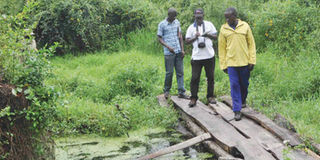Bigo bya Mugenyi: An abandoned treasure?

Tourists cross River Kachinga at Bigo bya Mugenyi. PHOTO BY TMARTIN SSEBUYIRA
What you need to know:
TREASURE? Bigo bya Mugenyi commonly taught about in Uganda’s primary school history is slowly vanishing, save for a few African traditional believers who keep it afloat by refurbishing the forts and going there for prayers. Martin Ssebuyira found out.
On arrival at Bigo Bya Mugenyi at about 50 kilometres from Sembabule town in Mawogola County, is a police post with tourism police.
Emmanuel Singel the head guide is at hand to lead you to the jungle sprawled out on a rugged landscape that will lead you to the gate at the site named Kabeho.
At Kabeho, there are very old spears, which guards used at the camp before reaching the rivers Katonga and Kachinga rivers. At these rivers visitors draw water for cleansing themselves before trekking the long journey to the Bigo Bya Mugenyi forts.
Thereafter, you move through thickets to find scenic views of dark green vegetation that covers the hills. Singel says the exceptionally deep green strip presents the path of the green trenches but for centuries the hidden site has not surrendered its secrets to curious inquirers.
Bigo-bya-Mugenyi has been reclaimed by the jungle. There is plenty of wildlife and the attendant poachers. “We have bush backs, leopards, and snakes but not a single tourist has ever been attacked,” Singel assures me.
Local tradition has it that it is ominously unlucky to be rained on while at Bigo bya-Mugenyi, literally translated as ‘forts of a stranger’.
Finally, a very steep hill will lead you to the first site of Bigo bya Mugenyi . There are many grass-thatched huts where the keepers live. As you move forward, there is a fenced and well-kept site on a raised ground where people go to pray to the Chwezi gods for blessings and wealth.
Just below this site is a big hut enclosed in bamboo. Inside it is adorned with bamboos and mats. There are calabashes from which people take milk and water and also offer milk sacrifices. There are big drums that are sounded when people gather to pray and pay homage to the demi gods. You cannot miss the baskets too where people put money to thank the gods.
About two kilometres away from Bigo bya Mugenyi are other cultural sites of Ndawula and Nakayima with similar sites like Mugenyi’s fort.
Ndawula
“People used to gather here from different forts to get blessings but all these gods just disappeared and are just being kept by people who gather there for prayers,” says Singel.
“We receive about 20-40 people who come to pray to the Chwezi gods and once in a while tourists,” Singel adds that he does voluntary work but survives on tips offered by people as he prays to the Chwezi gods for protection.
The different sites of Mugenyi, Nakayima and Ndawula were thronged by various people to get blessings and ask for what they want as it is still the case up to date.
The journey of about two or three miles between the sites must be made on foot because it is a holy ground. It is a brutal climb because the hills are exceptionally steep with the spiky undergrowth.
Nobody can explain why Ndawula and Nakayima forts are not as prominent as Mugenyi but the guide says because Mugenyi’s fort was nearer and had mercy on people, it made the site more prominent than others.
The generally accepted tradition among the Baganda of Mawogola county attributes the construction of Bigo to ‘the Stranger’; a person who is supposed to have entered Buganda from the north some six hundred years ago.
The site however presents a challenge that no Ugandan authority or scholar has cared to take up. As a historical site it is totally unprotected except perhaps, on paper.
Many Ugandans suggest that Bigo-bya-Mugenyi should be gazetted as a historical site and should be cordoned off and have a permanent guard instituted.




